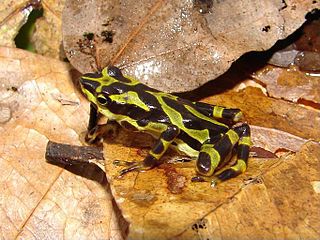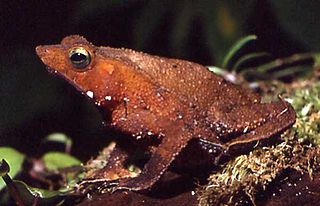Rhinella chrysophora, sometimes known as the Rio Viejo toad, is a species of toad in the family Bufonidae. It is endemic to the Cordillera Nombre de Dios on the Atlantic versant in north-central Honduras.

Atelopus balios, the Rio Pescado stubfoot toad, is a species of toad in the family Bufonidae. It is endemic to southwestern Ecuador, with records from Pacific lowlands in Azuay, Cañar, and Guayas Provinces. It is a rare species that was already suspected to be extinct, but a single specimen was discovered in 2011 by a team from Conservation International during a hunt for missing amphibians. The decline in amphibian populations is well documented. The Atelopus balios is Critically Endangered as a result of the widespread amphibian Chytridiomycosis fungus that has decimated other amphibian populations. There are only 10 known findings of the tadpole, Atelopus balios.

Atelopus certus, the Darien stubfoot toad or Toad Mountain harlequin frog, is a species of toad in the family Bufonidae endemic to Panama.

Atelopus chiriquiensis, the Chiriqui harlequin frog or Lewis' stubfoot toad, is an extinct species of toad in the family Bufonidae that was found in the Cordillera de Talamanca in Costa Rica and western Panama. Its natural habitats were stream margins in lower montane wet forests and rainforests. Its elevational range was 1,400–2,500 m (4,600–8,200 ft) asl.

Atelopus cruciger, also known as the Veragua stubfoot toad or Rancho Grande harlequin frog, is a species of toad in the family Bufonidae. It is endemic to Venezuela and is known from the central Venezuelan Coastal Range. The species was already suspected to be extinct because, despite considerable effort, none had been found since 1986. However, in 2003, a small population was found, with few other locations discovered later. It is mainly threatened by chytridiomycosis. It is locally called sapito rayado.

The elegant stubfoot toad or Pacific jambato frog is a species of toad in the family Bufonidae found in lowlands and Andean slopes of northwest Ecuador to 1,140 m (3,740 ft) asl and on the Gorgona Island, off southwest coast of Colombia. It was described by George Albert Boulenger in 1882 based on a specimen collected by Edward Whymper. It is known in Spanish as rana jambato del Pacífico or simply jambato del Pacífico.
Atelopus famelicus is a species of toad in the family Bufonidae endemic to Colombia. It is known from the Cordillera Occidental in Cauca and Valle del Cauca departments.
Atelopus farci, the forest stubfoot toad, is a species of toad in the family Bufonidae. It is endemic to Colombia and only known from its type locality, Granjas del Padre Luna, in Albán, Cundinamarca, on the western flank of the Cordillera Oriental at about 2,100 m (6,900 ft) above sea level. Its natural habitat is cloud forest where it lives in streams.

Atelopus ignescens, the Jambato toad or Quito stubfoot toad, is a species of toad in the family Bufonidae. It is endemic to the northern Andes of Ecuador. This once abundant species was believed to be extinct until its rediscovery in 2016. The specific name ignescens means "to catch fire", presumably in reference to the orange ventral color of this species.

Atelopus laetissimus is a species of toad in the family Bufonidae. It is endemic to Colombia and only known from the area of its type locality in the northwestern part of the Sierra Nevada de Santa Marta, in the Magdalena Department.
Atelopus planispina is a species of toad in the family Bufonidae. It is endemic to the eastern slopes of the Andes of Ecuador. According to the IUCN SSC Amphibian Specialist Group, it is restricted to the Napo Province, although other sources suggest somewhat wider range. It has not been seen since 1985 and might already be extinct. Common names Planispina's harlequin frog, Napo stubfoot toad, and flat-spined atelopus have been coined for it.
Atelopus senex is an extinct species of toad in the family Bufonidae. It was endemic to Costa Rica and known from the Cordillera Central and Cordillera de Talamanca at elevations of 1,100–2,200 m (3,600–7,200 ft) asl.

Atelopus spurrelli is a species of toad in the family Bufonidae. It is endemic to Colombia and occurs in the Pacific lowlands and foothills of the Cordillera Occidental. The specific name spurrelli honors Herbert George Flaxman Spurrell, a British physician and zoologist. Common name Condoto stubfoot toad has been coined for this species.
Atelopus subornatus is a species of toad in the family Bufonidae. It is endemic to Colombia and is restricted to the Cordillera Oriental in the Cundinamarca Department. Common name Bogota stubfoot toad has been coined for this species.
The three-coloured harlequin toad is a species of toad in the family Bufonidae. It is found in Bolivia and Peru. Its natural habitats are subtropical or tropical moist montane forests and rivers. It is threatened by habitat loss.

Rhinella proboscidea is a species of small South American toad in the family Bufonidae, common in the Amazon rainforest. It is the only species known to practice reproductive necrophilia.

Ingerophrynus quadriporcatus is a species of toad in the family Bufonidae. Its common names are long-glanded toad, four-ridged toad and greater Malacca toad. It is found in Peninsular Malaysia, Singapore, Borneo, Sumatra, and the Natuna Islands. Its natural habitats are swamp forests, but it has also been found on rubber plantations. It breeds in standing water.

Atelopus eusebiodiazi is a species of toads in the family Bufonidae. It is endemic to northwestern Peru and only known from its type locality in Huamba, near Ayabaca, Piura Region. The specific name eusebiodiazi honors Eusebio Diaz, taxidermist at the Museum of Natural History, Lima, and the collector of the holotype.

Atelopus patazensis is a species of toads in the family Bufonidae. It is endemic to Peru and only known from its type locality in Quebrada Los Alisos, near Pataz in the La Libertad Region. There is, however, an unverified observation from Llacuabamba, about 40 km south of Pataz.

Atelopus pyrodactylus is a species of toad in the family Bufonidae. It is endemic to Peru and only known from its type locality in the northern section of the Río Huallaga basin, Department of San Martín, on the eastern slope of the Cordillera Central. The specific name pyrodactylus refers to the light orange fingers and toes of this frog.















